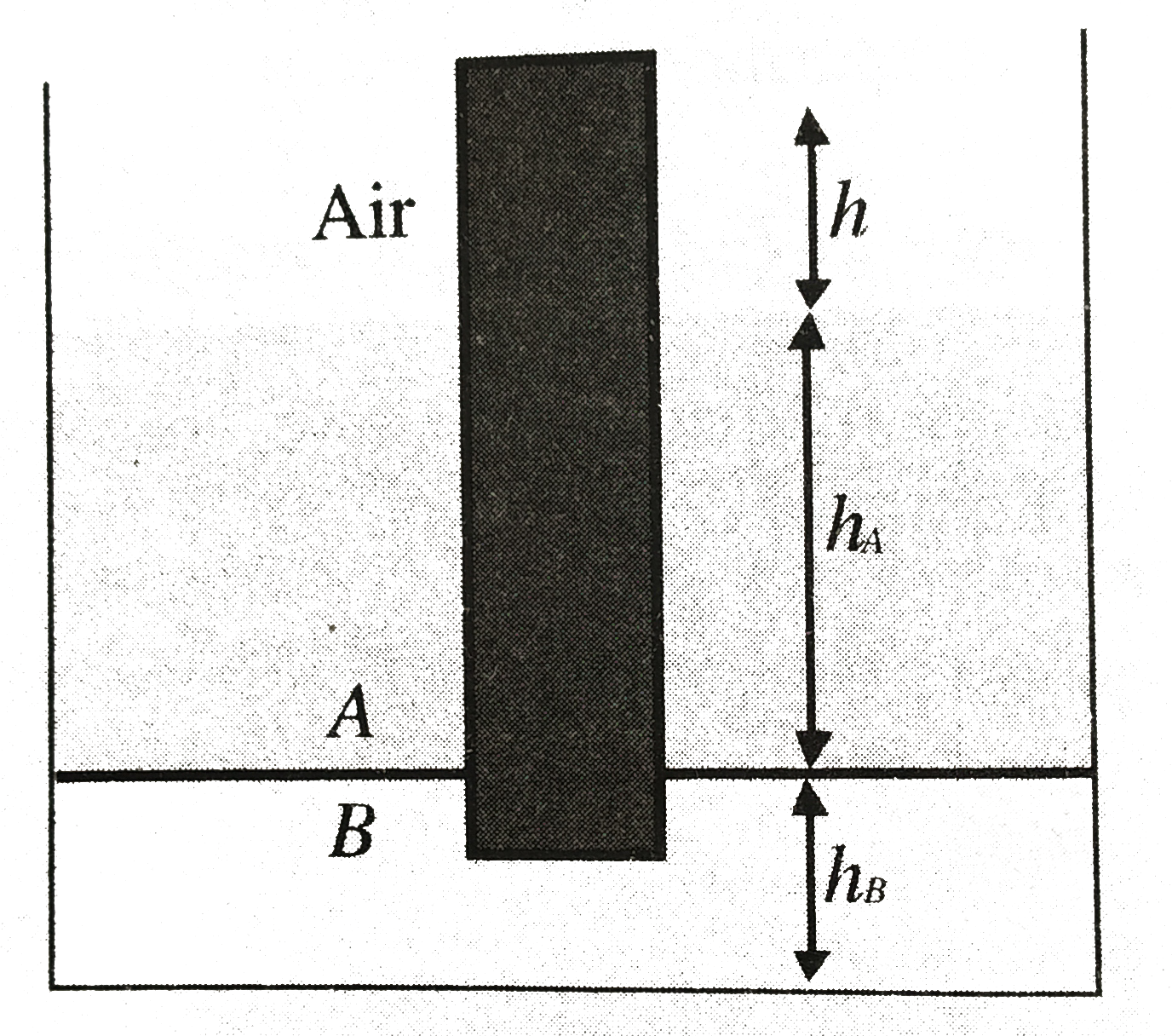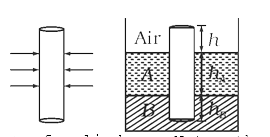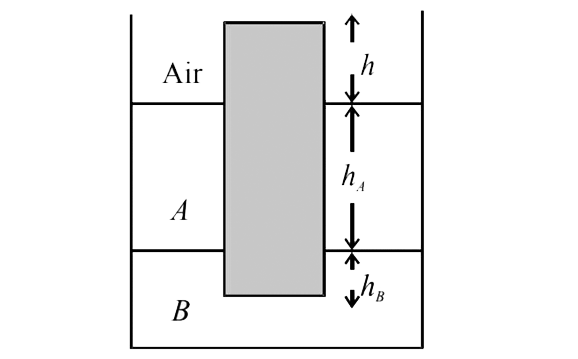A uniform solid cylinder of density 0.8g/cm3 floats in equilibrium in a combination of two non mixin liquids A and B with its axis vertical. The densities of liquids A and B are 0.7g/cm/(3) and 1.2g/cm3, respectively. The height of liquid A is hA=1.2cm. The length of the part of the cylinder with liquid B is hB=0.8cm.

a. Find the total force exerted by liquid A on the cylinder.
Find h the length of part of the cylinder in air.
c.The cylinder is depressed in such a way that its top surface is just below the upper surface of liquid A and is then released. Find the aceleration of the cylinder immediately just after it is released.
The correct Answer is:(i) 0 (ii) 0.25 (iii) 106
(i) 0 (ii) 0.25 (iii) 106
(i) Liquid A is applying the hydrostatic force on cylinder from all the sides. So, net force is zero.
(ii) In equilibrium weight of cylinder = Net upthrust on the cylinder let s be the area of cross-section of the cylinder, then weight =(s)(h+hA+hB)ρcylinderg and upthrust on the cylinder= upthrust due to liquid A + upthrust due to liquid B = shAρAg+shBρBg
Equation these two, s(h+hA+hB)ρcylinderg=sg(hAρA+hBρB)
or (h+hA+hB)ρcylinder=hAρA+hBρB
Substituting,
hA=1.2cm,hB=0.8cmandρA=0.7g/cm3,ρB=1.2g/cm3andρcylinder=0.8g/cm3
In the above equation , we get h = 0.25 cm
(iii) Net upward force = extra upthrust =shρBg
∴ Net acceleration a=forcemass of cylinder
or a=shρBgs(h+hA+hB)ρcylinderora=shρBg(h+hA+hB)ρcylinder
Substituting the values of h,hAhB,ρBandρcylinder, We get a=g6 (upwards )

Topper's Solved these Questions
- BOOK - VMC MODULES ENGLISHCHAPTER - LIQUIDSEXERCISE - JEE MAIN (LEVEL - 1 )31videos
LIQUIDS
- BOOK - VMC MODULES ENGLISHCHAPTER - LAWS OF MOTION EXERCISE - IMPECCABLE53videos
LAWS OF MOTION
- BOOK - VMC MODULES ENGLISHCHAPTER - MAGNETIC EFFECTS OF CURRENT EXERCISE - JEE Advanced (Archive)78videos
MAGNETIC EFFECTS OF CURRENT
Similar Questions
A uniform solid cylinder of density 0.8g/cm3 floats in equilibrium in a combination of two non-mixing liquids A and B with its axis vertical.
The densities of the liquids A and B are 0.7g/cm3 and 1.2g/cm3, respectively. The height of liquid A is hA=1.2cm. The length of the part of the cylinder immersed in liquid B is hB=0.8cm.

(a) Find the total force exerted by liquid A on the cylinder.
(b) Find h, the length of the part of the cylinder in air.
(c) The cylinder is depressed in such a way that its top surface is just below the upper surface of liquid A and is then released. Find the acceleration of the cylinder immediately after it is released.View SolutionA uniform solid cylinder of density 0.8g/cm3 floats in equilibrium in a combination of two non-mixing liquids A and B with its axis vertical.
The densities of the liquids A and B are 0.7g/cm3 and 1.2g/cm3, respectively. The height of liquid A is hA=1.2cm. The length of the part of the cylinder immersed in liquid B is hB=0.8cm.

(a) Find the total force exerted by liquid A on the cylinder.
(b) Find h, the length of the part of the cylinder in air.
(c) The cylinder is depressed in such a way that its top surface is just below the upper surface of liquid A and is then released. Find the acceleration of the cylinder immediately after it is released.View Solution
Knowledge Check
- Question 1 - Select One
A block of wood of density 0.8gcm−3 has a volume of 60cm3 . The mass of block will be :
A60.8 gB75gC48gD0.013 g
A uniform solid cylinder of density 0.8g/cm3 floats in equilibrium in a combination of two non-mixing liquids A and B with its axis vertical.
The densities of the liquids A and B are 0.7g/cm3 and 1.2g/cm3, respectively. The height of liquid A is hA=1.2cm. The length of the part of the cylinder immersed in liquid B is hB=0.8cm.

(a) Find the total force exerted by liquid A on the cylinder.
(b) Find h, the length of the part of the cylinder in air.
(c) The cylinder is depressed in such a way that its top surface is just below the upper surface of liquid A and is then released. Find the acceleration of the cylinder immediately after it is released.View SolutionA solid cylinder of length L is in equilibrium in two different liquid A and B as shown in the figure.The density of liquid A 3ρ2 and liquid B is 3ρ.The density of cylinder is
View SolutionThe apparent depth of a liquid in a vessel is 15 cm, when its real depth is 20 cm. find the refractive index of the liquid.
View SolutionTwo solids A and B of density 2.5 g cm−3 and 0.80g cm−3 are placed in a liquid L of density 1.2 g cm−3 Which solid is likely to float and why?
View SolutionTwo immiscible of densities 2.5g/cm3 and 0.8g/cm3 are taken in the ratio of their masses as 2:3 respectively find the average density of the liquid conbination.
View SolutionA body of density 2.5g/cm3 is let free in a liquid of density 1.25g/cm3 . The downward acceleration of the of the body while sinking in the liquid is . _______
View SolutionTwo miscible liquids of densities 1.2gm/cm and 1.4gm/cm aer mixed with a proportion ratio of their volumes equal to 2.5: what is the density of redulting liquid?
View Solution

